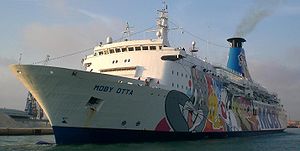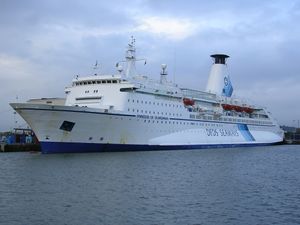MS Moby Otta
| 50x40px | This article includes a list of references, related reading or external links, but its sources remain unclear because it lacks inline citations. Please improve this article by introducing more precise citations where appropriate. (April 2009) |
 MS Moby Otta | |
| Career | |
|---|---|
| Name: |
1976-1982: Tor Scandinavia 1982-1983: World Wide Expo 1983-1991: Tor Scandinavia 1991-2006: Princess of Scandinavia 2006-present: Moby Otta |
| Owner: |
1976-1981: Tor Line 1981-1983: DFDS 1983-1991: Difko XXXIII 1991-2006: DFDS 2006-present: Moby Lines |
| Operator: |
1976-1980: Tor Line 1980-1981: Sessan Tor Line 1981: Tor Line 1981-2006: DFDS Seaways 2006-present: Moby Lines |
| Port of registry: |
1976-1981: Gothenburg, 1981-1991: Esbjerg, File:Flag of Denmark.svg Denmark 1991-2006: Copenhagen, File:Flag of Denmark.svg Denmark 2006-present: Naples, 22x20px Italy |
| Builder: | Flender Werke, Lübeck, West Germany |
| Yard number: | 608 |
| Laid down: | 2 April 1975 |
| Launched: | 4 November 1975 |
| Christened: | 15 April 1976by Jennifer Wilson |
| Acquired: | 12 April 1976 |
| In service: | 15 April 1976 |
| Identification: | IMO number: 7361324 |
| Status: | In service |
| Notes: | Sister ship to MS Moby Drea |
| General characteristics (as built) | |
| Tonnage: | 15673 GRT |
| Displacement: | 3,290 metric tons deadweight (DWT) |
| Length: | 182.26 meters |
| Beam: | 23.62 meters |
| Draught: | 6.20 meters |
| Installed power: |
4 × Pielstick PC3 12 V480 diesels 33540 kW |
| Speed: | 27.2 knots |
| Capacity: |
1507 passengers 1416 beds 420 passenger cars 910 lanemeters |
| General characteristics (after 1998 refit) | |
| Tonnage: | 21545 GRT |
| Displacement: | 3335 DWT |
| Length: | 184.55 meters |
| Beam: | 26.40 meters |
| Draught: | 6.20 meters |
| Capacity: |
1507 passengers 1617 beds 420 passenger cars 910 lanemeters |
| General characteristics (after 2007 refit) | |
| Capacity: |
1900 passengers 500 passenger cars |
MS Moby Otta is a cruiseferry, currently owned by the Italy-based shipping company Moby Lines and operated on their Livorno–Olbia service. She was built in 1976 by Flender Werke, Lübeck, West Germany as MS Tor Scandinavia for Tor Line. Between 1991 and 2006 she sailed as MS Princess of Scandinavia.
Contents
History
Tor Line service
Tor Line had been established in 1966 by two Swedish companies to operate car-passenger services between Sweden, England and the Netherlands with modern car-passenger ferries. By the early 1970s Tor Line had essentially defeated their main competitors on the route, Rederi AB Svea and Swedish Lloyd. To consolidate their leading position the company decided to order a pair of new state-of-the-art ferries for the service. The new ships were to be the fastest ferries in the world, as well as largest, except for the Soviet Union's Belorussiya class ships.
The first sister, MS Tor Britannia, was delivered in May 1975. Just a month earlier the keel had been laid for the second sister, to be called MS Tor Scandinavia. Tor Scandinavia was eventually delivered on April 12, 1976. The two ships revolutionized trans-North Sea traffic, being capable of speeds in excess of 27 knots and offering services hitherto unknown on ferries in that route. Although technically modern in many ways, the ships' exteriors were quite traditional in their style, reminiscent more of ocean liners than ferries. The sole exception to this were two massive loading ramps in the rear of the ship, which were necessary as the ships had no forward car-gate for safety reasons.
For all of its service with Tor Line, the Tor Scandinavia alternated with its sister on the routes Gothenburg–Immingham (later Felixstowe) and Gothenburg–Amsterdam. Already in autumn 1976 the ship had her first major accident, when she ran into a major storm on the North Sea. Nine windows were smashed and the ship started taking in water from the forward air intakes on the superstructure. Eventually the ship arrived in Amsterdam approximately 18 hours behind schedule.
It soon turned out there weren't in fact enough passengers for both new ships during the winter season. As a result Tor Line chartered the Tor Scandinavia as an expo-ship in January-February 1979 (to Holland Expo for use in the Middle East), again in January-April 1980 (to Scan-Arab Expo for a fair cruise around the Middle East and Asia) and again in December 1980 – April 1981 (again to Holland Expo for use in the Middle East). The winter passenger numbers weren't the only problem, and Tor Line started looking to form a partnership with another shipping company. In January 1980 Sessan Tor Line was formed as a collaborative company between Tor Line and Sessan Line, another Swedish company that had traffic between Gothenburg and Frederikshavn, Denmark. As a result Sessan Line's mermaid-logo was added alongside Tor Line's logo in the Tor ships' funnels. Sessan Tor Line proved to be short-lived however, and in April 1981 the collaboration ended.
In December 1981 Tor Line was sold to the Danish company DFDS. The only immediate change for Tor Scandinavia was that her homeport was altered from Gothenburg to Esbjerg, Denmark. She soon received DFDS's white hull and dark funnel colours (as opposed to the dark hull and white funnel of Tor Line), however she was officially marketed as a DFDS Tor Line ship due to the good reputation of Tor Line in Sweden. Between October 1982 and February 1983 Tor Scandinavia was again chartered as an expo-ship to Dutch companies. This time her name was temporarily changed to MS World Wide Expo and she sailed extensively in Asia and the Middle East. After the end of the charter she returned to Sweden–England traffic, although the English terminus was altered from Felixstove to Harwich. Later in the same year DFDS decided to abandon the line to Amsterdam completely, and use only one ship—Tor Scandinavia—on the Gothenburg to Harwich route, whereas the Tor Britannia sailed from Harwich to Esbjerg. Between 1981 and 1983, Tor Scandinavia also starred in the BBC soap opera Triangle, which was shot entirely on board the ship. In the series she portrayed MS Dana Anglia of the fictional Triangle Line.[1] Confusingly a real ship named Dana Anglia was sailing at the time with DFDS.[2]
In 1988 DFDS adopted a new marketing name, Scandinavian Seaways, for their passenger division. As a result the Tor Scandinavia was painted in a new, attractive white/blue livery, but the change also meant disappearance of the name Tor Line from her hull. However, she and her sister did still retain their original names. In the same year the ship was moved to Danish International Shipregistry, which meant less operational costs for the company.
In 1989 Scandinavian Seaways decided to start trafficking from Gothenburg to Amsterdam again, so from February 1989 onwards Tor Scandinavia alternated on the routes Gothenburg–Harwich and Gothenburg–Amsterdam. In September of the same year a fire broke out on board during a crossing to Harwich, and the ship was forced to sail to Esbjerg instead. From there she continued to Nobiskrug, Rendsburg, Germany for repairs. During summer season 1990 the ship's route was altered to Gothenburg–Newcastle, and from August 1990 onwards to Gothenburg–Harwich–Esbjerg, alongside the old Gothenburg–Amsterdam service.
During January and February 1991 the Tor Scandinavia was rebuilt at Blohm + Voss, Hamburg, Germany. After the rebuilding she received a new name, MS Princess of Scandinavia, to bring her name in-line with Scandinavian Seaways' other ships (her sister had been renamed MS Prince of Scandinavia a few months earlier). In 1994 the ship occasionally sailed between Kristiansand, Norway, and IJmuiden, the Netherlands. In June of the same year problems with one of the propellers meant the ship's speed was limited to 15 knots (28 km/h). While docked in Kristiansand to fix the problem the ship capsized, causing extensive damage.
To conform to new safety regulations the Princess of Scandinavia was rebuilt with side sponsons in January–March 1998 at Gdańsk Shiprepair Yard, Gdańsk, Poland. From the same year onwards her itineraries also changed somewhat: she served Gothenburg–Harwich all year round, but alongside that she served Gothenburg–Copenhagen during the winter season and Gothenburg–Newcastle during the summer season. In 1999 DFDS abandoned the marketing name Scandinavian Seaways and the company name reverted to DFDS Seaways. In March 2000 the ship's itineraries were changed again, from thereon she served Gothenburg–Kristiansand–Newcastle all year round. The route change was partially dictated by the end of tax free sales in intra-EU traffic, as calling in Norway allowed the continuation of tax free sales on board.
During a crossing to Kristiansand in the night between May 17 and 18, 2002, a fire broke out in the ship's engine room between the two main engines and spread to the funnel. The fire was put in the morning of the 18th, and the ship could continue its journey towards Kristiansand. Between May 21 and June 14 the ship was repaired at Fredericia Varv, Fredericia, Denmark, after which she was back in normal traffic.
The ship spent January 2004 laid up in Gothenburg where her interiors were brought up to date. In January 2005 she was again rebuilt, this time with a new sprinkler system and catalytic converters, and her cabins and public areas were upgraded. However, despite these changes the end was near for the ship's service with DFDS. She spent January 2006 laid up in Gothenburg, after which she momentarily served on the Newcastle–IJmuiden route during the time when MS Duke of Scandinavia had already been chartered to Brittany Ferries but her replacement MS King of Scandinavia was not yet ready for service. After this brief stint on the Dutch service Princess returned to Gothenburg–Kristiansand–Newcastle service. At this time (possibly earlier?) a 23-hour cruise from Gothenburg to Kristiansand and back was done every Friday.
On September 6 2006 DFDS Seaways reported that it had purchased MS Fjord Norway from the Norway-based Fjord Line, and would be continuing the ship's traffic from the UK to Norway. As a result of this the Princess of Scandinavia was sold and would stop trading for DFDS on 1 November of the same year. The buyer was later revealed to be Italian Moby Lines, who had already bought the Princess' sister in 2003. When the Princess of Scandinavia was taken out of service, it marked the end of 160 years of direct passenger ship traffic between Sweden and Great Britain. The vessel was withdrawn due to being old and a high usage of fuel. The additional time this route was closed was during WW2.
Moby Lines service
On 2 November 2006 Moby Lines took over the Princess of Scandinavia in Frederikshavn, Denmark, and she was renamed M/S Moby Otta. Between November 2006 and May 2007 she was rebuilt with a higher car-capacity and her cabin arrangements altered. Originally it was reported that the Moby Otta would open a new route for Moby Lines, connecting Genoa and Porto Torres. Later reports indicate she will replace her sister MS Moby Drea on the Livorno–Olbia route, and the Moby Drea will be transferred to the Genoa–Porto Torres route instead.
References
- ↑ "Triangle". 2006-08-28. http://www.geocities.com/uk_soaps/Triangle/. Retrieved 2009-03-04.
- ↑ Asklander, Micke. "M/S Dana Anglia (1978)" (in Swedish). Fakta om Fartyg. http://www.faktaomfartyg.se/dana_anglia_1978.htm. Retrieved 2009-03-04.
External links
| Moby Otta
]]

